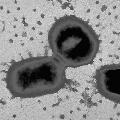



|
| This project is collaborated between The Forsyth Institute (TFI) and The Institute for Genomic Research (TIGR), and is funded by National Institute of Dental and Craniofacial Research (NIDCR) |
|
|
|||||||||||||||||||||||||
Phylogeny of P. gingivalisPorphyromonas gingivalis has been renamed many times as the phylogeny of black pigmented bacteroides was unraveled and new species split off. These names include: Bacterium melaninogenicum, Haemophilus melaninogenicus, Bacteroides melaninogenicus, Bacteroides asaccharolyticus, Bacteroides gingivalis, and finally Porphyromonas gingivalis (McBride et al., 1993). The last name change occured when the genus Bacteroides was divided into three related genera, Bacteroides, Porphyromonas and Prevotella. These taxonomic changes make examination of the older literature challenging. Even recent reviews of antibiotic resistance refer to Bacteroides when they actually mean species in the genera Bacteroides, Porphyromonas and Prevotella (Rasmussen et al., 1993). Porphyromonas gingivalis is a member of Cytophaga/Flavobacter/Bacteroides phylum of bacteria In previous studies representative strains of 36 species in the genera Bacteroides, Porphyromonas and Prevotella were examined by 16S rRNA sequence analysis (Paster et al., 1994; included in Appendix). Porphyromonas gingivalis was found to belong in the porphyromonas division of the bacteroides, one of five groups of bacteria that comprise the Cytophaga/ Flavobacter/ Bacteroides phylum (CFB) described by Woese (1987). The genome size of most CFB organisms is in the 4-6 Mb range (Salyers, personal communication); however, the P. gingivalis genome is only approximately 2.2 Mb (see Preliminary Results) which makes it an ideal candidate for a genome project representing the CFB phylum. Bacteroides fragilis and B. thetaiotaomicron are among the most commonly recovered anaerobes in intra-abdominal infections, and their resistance to antibiotics adds to their clinical importance (Davies, 1996; Jousimies-Somer et al., 1995). Examination of Medline 1992-1996 database demonstrates that P. gingivalis is the most intensively studied organism in the CFB phylum. The following numbers of articles are cited for the following genera: Bacterides 965, Porphyromonas 621, Prevotella 373, Flavobacterium 163, Cytophaga 27; and the following individual species: P. (B.) gingivalis 547, B. fragilis 440, and B. thetaiotaomicron 46. |
||||
|
This page is created and maintained by Drs. Margaret Duncan, Floyd Dewhirst, and Tsute Chen, Department of Molecular Genetics, The Forsyth Institute . Last modified on 02/20/2002 Copyright 2000, 2001, 2002 by The Forsyth Institute |